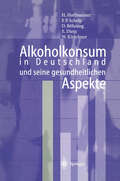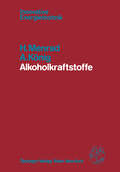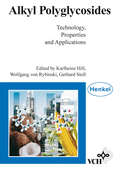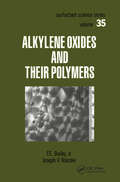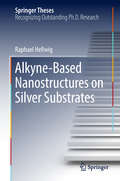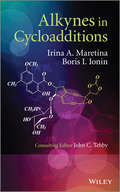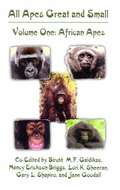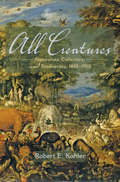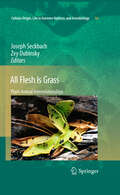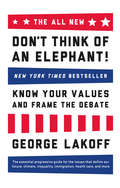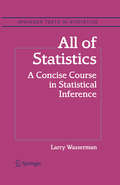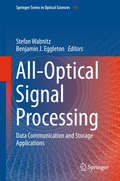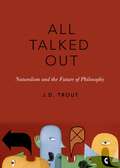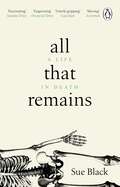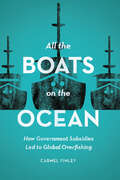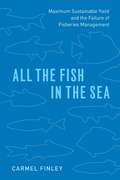- Table View
- List View
Alkoholkonsum in Deutschland und seine gesundheitlichen Aspekte
by Hans Hoffmeister F.P. Schelp D. Böhning B. Dietz W. KirschnerDer Konsum alkoholischer Getränke (Menge, Häufigkeit) in der deutschen Wohnbevölkerung wird differenziert beschrieben. Zusammenhänge zwischen den Trinkgewohnheiten einerseits sowie wichtigen Gesundheitsindikatoren andererseits werden dargestellt. Weiter werden die Sterberaten an Herz-Kreislaufkrankheiten und an allen Todesursachen von Abstinenten und Gruppen mit unterschiedlichem Alkoholkonsum verglichen. Diese erste größere Analyse zum Alkoholkonsum und seine gesundheitlichen Auswirkungen bestätigt internationale Erkenntnisse, daß leichter und moderater Alkoholkonsum unabhängig von der Getränkeart subjektive und objektive gesundheitliche Vorteile mit sich bringt und mit einer statistisch signifikant niedrigen Sterblichkeit verbunden ist, starker und sehr starker Alkoholgenuß bewirkt aber das Gegenteil.Die Analysen wurden auf dem aktuellen Stand des epidemiologischen Wissens und der statistisch-epidemiologischen Verfahren durchgeführt.
Alkyl Polyglycosides: Technology, Properties, and Applications
by Karlheinz Hill Wolfgang Von Rybinski Gerhard StollThe first comprehensive survey on the uses of alkyl polyglycosides as renewable ressources for the chemical industry. Experts from industry show in detail how alkyl polyglycosides can help chemists to improve their products. Since quite a few years, renewable Ressources are of increasing interest for the chemical industry. Alkyl polyglycosides are among the frequently used substances produces from renewable ressorces. Their science as well as technological applications are described in this book competently and with a focus on industrial use.
Alkylene Oxides and Their Polymers
by F.E. Bailey Joseph V. KoleskeA comprehensive treatment of a large family of polymers useful in a wide range of applications in such fields as automotive, pharmaceutical, cosmetic, metal-working, mining, industrial coating, textile, construction, and home furnishings. Summarizes the chemistry and mechanisms; provides basic prepa
Alkylene Oxides and Their Polymers
by F.E. Bailey Joseph V. KoleskeA comprehensive treatment of a large family of polymers useful in a wide range of applications in such fields as automotive, pharmaceutical, cosmetic, metal-working, mining, industrial coating, textile, construction, and home furnishings. Summarizes the chemistry and mechanisms; provides basic prepa
Alkyne‐Based Nanostructures on Silver Substrates (Springer Theses)
by Raphael HellwigAcetylenic precursors are important reactants for creating carbon-based architectures via linkage reactions. While their capability of forming intermolecular bonds is well investigated in solution, very few systematic studies have been carried out to create alkyne-based nanostructures on metal substrates under ultra-high vacuum conditions. Synthesizing extended and regular carbon scaffolds requires a detailed knowledge of alkyne chemistry in order to control reaction pathways and limit unwanted side reactions. Using the bottom-up approach on metal surfaces, the authors establish protocols to fabricate regular architectures built up by the on-surface formation of selective organometallic and C-C bonds with thoughtfully designed alkyne-functionalized monomers. The structural and functional properties of the resulting organometallic and covalent nanostructures are characterized by means of scanning tunneling microscopy. The results open up new perspectives in the fields of heterogeneous catalysis and the on-surface synthesis of functional interfaces under mild reaction conditions.
Alkynes in Cycloadditions
by Irina A. MaretinaAcetylene systems present a new route to cyclic compounds as an alternative to more traditional methods employed in classical organic chemistry. The synthesis of cyclic structures based on acetylene systems has important applications in the formation of nanostructures, naturally occurring compounds and chemosensory materials for the design of nonlinear optics, electronic and photonic devices. Alkynes in Cycloadditions presents a modern review of regioselective synthesis of aromatic and non-aromatic carbocyclic and heterocyclic ring systems based primarily on [2+2+2] and [4+2] cycloadditions, and other reactions of acetylenic units including enediynes and enyne-allenes. Topics covered include: New strategies for the formation of aromatic and polynuclear hydrocarbons based on (Z)-hex-3-en-1,5-diyne and (Z)-hepta-1,2,4-triene-6-yne blocks. One-step synthesis of benzene derivatives, β-substituted naphthalenes and acenes by the cycloaromatization of enediynes and enyne-allenes by Bergman, Myers-Saito and Shmittel. Mechanisms of cycloaromatization resulting in the formation of fulvene and indene systems. Heterocyclization involving enyne-carbodiimides. New achievements in classical cycloaddition reactions such as the Diels-Alder condensation with acetylenic dienophiles and [2+2] cycloadditions with acetylene components Alkynes in Cycloadditions presents a comprehensive summary of the literature on methods for the synthesis of ring systems from acetylenes for academic researchers working in the fields of organic synthesis, physical organic chemistry, organometallic chemistry, catalysis, materials science, nanomaterials and biochemistry.
Alkynes in Cycloadditions
by Irina A. MaretinaAcetylene systems present a new route to cyclic compounds as an alternative to more traditional methods employed in classical organic chemistry. The synthesis of cyclic structures based on acetylene systems has important applications in the formation of nanostructures, naturally occurring compounds and chemosensory materials for the design of nonlinear optics, electronic and photonic devices. Alkynes in Cycloadditions presents a modern review of regioselective synthesis of aromatic and non-aromatic carbocyclic and heterocyclic ring systems based primarily on [2+2+2] and [4+2] cycloadditions, and other reactions of acetylenic units including enediynes and enyne-allenes. Topics covered include: New strategies for the formation of aromatic and polynuclear hydrocarbons based on (Z)-hex-3-en-1,5-diyne and (Z)-hepta-1,2,4-triene-6-yne blocks. One-step synthesis of benzene derivatives, β-substituted naphthalenes and acenes by the cycloaromatization of enediynes and enyne-allenes by Bergman, Myers-Saito and Shmittel. Mechanisms of cycloaromatization resulting in the formation of fulvene and indene systems. Heterocyclization involving enyne-carbodiimides. New achievements in classical cycloaddition reactions such as the Diels-Alder condensation with acetylenic dienophiles and [2+2] cycloadditions with acetylene components Alkynes in Cycloadditions presents a comprehensive summary of the literature on methods for the synthesis of ring systems from acetylenes for academic researchers working in the fields of organic synthesis, physical organic chemistry, organometallic chemistry, catalysis, materials science, nanomaterials and biochemistry.
All Aboard, Stage 4: Blackberry Pudding
by Leonie BennettAll Aboard teaches the strategies children need to become successful readers. It offers carefully-structured materials to develop sight vocabulary, phonological awareness and information retrieval through three specially-designed strands for Infants. It then develops the higher order reading and writing skills necessary for genuine literacy at Junior level.
All Aboard, Stage 4: Blackberry Pudding
by Leonie BennettAll Aboard teaches the strategies children need to become successful readers. It offers carefully-structured materials to develop sight vocabulary, phonological awareness and information retrieval through three specially-designed strands for Infants. It then develops the higher order reading and writing skills necessary for genuine literacy at Junior level.
All Apes Great and Small: Volume 1: African Apes (Developments in Primatology: Progress and Prospects)
by Nancy Erickson Briggs Jane Goodall Gary L. Shapiro Lori K. Sheeran Biruté M. F. GaldikasMany of the papers in this volume were first presented at the Third International Great Apes of the World Conference, held July 3-6, 1998 in Kuching, Sarawak, Malaysia. The editors of this volume, the first in a two-volume series, are world renowned, having dedicated most of their lives to the study of great apes. The world's premiere primatologists, ethologists, and anthropologists present the most recent research on both captive and free-ranging African great apes. These scientists, through deep personal commitment and sacrifice, have expanded their knowledge of chimpanzees, bonobos, and gorillas. With forests disappearing, many of these studies will never be duplicated. This volume, and all in the Developments in Primatology book series, aim to broaden and deepen the understanding of this valuable cause.
All Creatures: Naturalists, Collectors, and Biodiversity, 1850-1950 (PDF)
by Robert E. KohlerWe humans share Earth with 1.4 million known species and millions more species that are still unrecorded. Yet we know surprisingly little about the practical work that produced the vast inventory we have to date of our fellow creatures. How were these multitudinous creatures collected, recorded, and named? When, and by whom? Here a distinguished historian of science tells the story of the modern discovery of biodiversity. Robert Kohler argues that the work begun by Linnaeus culminated around 1900, when collecting and inventory were organized on a grand scale in natural history surveys. Supported by governments, museums, and universities, biologists launched hundreds of collecting expeditions to every corner of the world. Kohler conveys to readers the experience and feel of expeditionary travel: the customs and rhythms of collectors' daily work, and its special pleasures and pains. A novel twist in this story is that survey collecting was rooted not just in science but also in new customs of outdoor recreation, such as hiking, camping, and sport hunting. These popular pursuits engendered a wide scientific interest in animals and plants and inspired wealthy nature-goers to pay for expeditions. The modern discovery of biodiversity became a reality when scientists' desire to know intersected with the culture of outdoor vacationing. General readers as well as scholars will find this book fascinating.
All Flesh Is Grass: Plant-Animal Interrelationships (Cellular Origin, Life in Extreme Habitats and Astrobiology #16)
by Zvy Dubinsky and Joseph SeckbachThis new book takes us through a journey from early life to modern agriculture. The thirty eight authors present current studies on the interrelation of plants-animals. This topic has always fascinated man, as evidenced even by the first chapters of Genesis. The world of aqueous and terrestrial fauna appeared on early earth only after the flora covered the areas with the green pigmentation. Almost all life depends upon sunlight via the photosynthesis of the botanical world. We read abut the harnessing of bee pollination of crops to make it an essential component of modern agriculture endeavor. Some plants seduce insects for pollination by their appearance (e.g., disguised orchids entice visitors); there is the production of sweet nectar as a bribe in flowers to attract bees, butterflies, and honey-sucking birds. A particular outstanding phenomena are the carnivorous plants that have developed trapping and digesting systems of insects and higher animals.
The ALL NEW Don't Think of an Elephant!: Know Your Values and Frame the Debate
by George LakoffTen years after writing the definitive, international bestselling book on political debate and messaging, George Lakoff returns with new strategies about how to frame today’s essential issues. Called the “father of framing” by The New York Times, Lakoff explains how framing is about ideas—ideas that come before policy, ideas that make sense of facts, ideas that are proactive not reactive, positive not negative, ideas that need to be communicated out loud every day in public. The ALL NEW Don’t Think of an Elephant! picks up where the original book left off—delving deeper into how framing works, how framing has evolved in the past decade, how to speak to people who harbor elements of both progressive and conservative worldviews, how to counter propaganda and slogans, and more. In this updated and expanded edition, Lakoff, urges progressives to go beyond the typical laundry list of facts, policies, and programs and present a clear moral vision to the country—one that is traditionally American and can become a guidepost for developing compassionate, effective policy that upholds citizens’ well-being and freedom.
All of Statistics: A Concise Course in Statistical Inference (Springer Texts in Statistics)
by Larry WassermanTaken literally, the title "All of Statistics" is an exaggeration. But in spirit, the title is apt, as the book does cover a much broader range of topics than a typical introductory book on mathematical statistics. This book is for people who want to learn probability and statistics quickly. It is suitable for graduate or advanced undergraduate students in computer science, mathematics, statistics, and related disciplines. The book includes modern topics like non-parametric curve estimation, bootstrapping, and classification, topics that are usually relegated to follow-up courses. The reader is presumed to know calculus and a little linear algebra. No previous knowledge of probability and statistics is required. Statistics, data mining, and machine learning are all concerned with collecting and analysing data.
All-Optical Noninvasive Delayed Feedback Control of Semiconductor Lasers
by Sylvia SchikoraThe stabilization of unstable states hidden in the dynamics of a system, in particular the control of chaos, received much attention in the last years. In this work, a well-known control method called delayed feedback control is applied for the first time entirely in the all-optical domain. A multisection semiconductor laser receives optical feedback from an external Fabry-Perot interferometer. The control signal is a phase-tunable superposition of the laser signal, and provokes the laser to operate in an otherwise unstable periodic state with a period equal to the time delay. The control is noninvasive, because the reflected signal tends to zero when the target state is reached.
All-Optical Signal Processing: Data Communication and Storage Applications (Springer Series in Optical Sciences #194)
by Stefan Wabnitz Benjamin J. EggletonThis book provides a comprehensive review of the state-of-the art of optical signal processing technologies and devices. It presents breakthrough solutions for enabling a pervasive use of optics in data communication and signal storage applications. It presents presents optical signal processing as solution to overcome the capacity crunch in communication networks. The book content ranges from the development of innovative materials and devices, such as graphene and slow light structures, to the use of nonlinear optics for secure quantum information processing and overcoming the classical Shannon limit on channel capacity and microwave signal processing.Although it holds the promise for a substantial speed improvement, today’s communication infrastructure optics remains largely confined to the signal transport layer, as it lags behind electronics as far as signal processing is concerned. This situation will change in the near future as the tremendous growth of data traffic requires energy efficient and fully transparent all-optical networks. The book is written by leaders in the field.
All Talked Out: Naturalism and the Future of Philosophy (The Romanell Lectures)
by J.D. TroutIn All Talked Out J.D. Trout exemplifies the power of science in a philosopher's hands, and takes a welcome look at the resulting fate of philosophy. Based on his 2013 Phi Beta Kappa Romanell Lectures, each chapter presents a novel and positive view of intellectual advancements with respect to traditional topics in philosophy, and explains why these achievements occurred despite the archaic and often retrograde influence of philosophical doctrine and method. Together, these two lines of inquiry lead the reader to understand that while foundational reflection remains as necessary as ever, philosophy, as it is conceived of in the halls of academia, no longer adds anything distinctively useful. At its best, philosophy is a place to grow new ideas. But many other disciplines can provide such incubation. At the same time, however, we don't have to kill philosophy; but we do have to figure out what is worth preserving. Following a spirited introduction, the first lecture takes stock of the growing field of evidence-based approaches to reasoning, and in light of these scientific developments, criticizes important failures in epistemology as it is currently practiced in the English speaking world. The second lecture examines the psychological impulse to explain, the resulting sense of understanding, and the natural limits of cognitively appreciating the subject we have explained. The final lecture presents the proper reaction to the idea that scientific evidence matters to responsible governance.
All Talked Out: Naturalism and the Future of Philosophy (The Romanell Lectures)
by J.D. TroutIn All Talked Out J.D. Trout exemplifies the power of science in a philosopher's hands, and takes a welcome look at the resulting fate of philosophy. Based on his 2013 Phi Beta Kappa Romanell Lectures, each chapter presents a novel and positive view of intellectual advancements with respect to traditional topics in philosophy, and explains why these achievements occurred despite the archaic and often retrograde influence of philosophical doctrine and method. Together, these two lines of inquiry lead the reader to understand that while foundational reflection remains as necessary as ever, philosophy, as it is conceived of in the halls of academia, no longer adds anything distinctively useful. At its best, philosophy is a place to grow new ideas. But many other disciplines can provide such incubation. At the same time, however, we don't have to kill philosophy; but we do have to figure out what is worth preserving. Following a spirited introduction, the first lecture takes stock of the growing field of evidence-based approaches to reasoning, and in light of these scientific developments, criticizes important failures in epistemology as it is currently practiced in the English speaking world. The second lecture examines the psychological impulse to explain, the resulting sense of understanding, and the natural limits of cognitively appreciating the subject we have explained. The final lecture presents the proper reaction to the idea that scientific evidence matters to responsible governance.
All That Remains: A Life in Death
by Professor Sue Black'Utterly gripping' - The Guardian 'Fascinating' - The Sunday Times 'Moving' - Scotsman 'Engrossing' - Financial Times Sue Black confronts death every day. As a Professor of Anatomy and Forensic Anthropology, she focuses on mortal remains in her lab, at burial sites, at scenes of violence, murder and criminal dismemberment, and when investigating mass fatalities due to war, accident or natural disaster. In All That Remains she reveals the many faces of death she has come to know, using key cases to explore how forensic science has developed, and examining what her life and work has taught her. Do we expect a book about death to be sad? Macabre? Sue's book is neither. There is tragedy, but there is also humour in stories as gripping as the best crime novel. Part memoir, part science, part meditation on death, her book is compassionate, surprisingly funny, and it will make you think about death in a new light. ________ SUE BLACK'S NEW BOOK, WRITTEN IN BONE, IS OUT NOW _________ 'One might expect [this book] to be a grim read but it absolutely isn't. I found it invigorating!' (Andrew Marr, BBC Radio 4 'Start the Week') 'Black's utterly gripping account of her life and career as a professor of anatomy and forensic anthropology manages to be surprisingly life-affirming. As she herself says, it is "as much about life as about death"' (PD Smith Guardian) 'An engrossing memoir . . . an affecting mix of personal and professional' (Erica Wagner, Financial Times) 'A model of how to write about the effect of human evil without losing either objectivity or sensitivity . . . Heartening and anything but morbid . . . Leaves you thinking about what kind of human qualities you value, what kinds of people you actually want to be with' (Rowan Williams, New Statesman) 'For someone whose job is identifying corpses, Sue Black is a cheerful soul . . . All That Remains feels like every episode of 'Silent Witness', pre-fictionalised. Except, you know, really good' (Helen Rumbelow, The Times)
All the Boats on the Ocean: How Government Subsidies Led to Global Overfishing
by Carmel FinleyMost current fishing practices are neither economically nor biologically sustainable. Every year, the world spends $80 billion buying fish that cost $105 billion to catch, even as heavy fishing places growing pressure on stocks that are already struggling with warmer, more acidic oceans. How have we developed an industry that is so wasteful, and why has it been so difficult to alter the trajectory toward species extinction? In this transnational, interdisciplinary history, Carmel Finley answers these questions and more as she explores how government subsidies propelled the expansion of fishing from a coastal, in-shore activity into a global industry. While nation states struggling for ocean supremacy have long used fishing as an imperial strategy, the Cold War brought a new emphasis: fishing became a means for nations to make distinct territorial claims. A network of trade policies and tariffs allowed cod from Iceland and tuna canned in Japan into the American market, destabilizing fisheries in New England and Southern California. With the subsequent establishment of tuna canneries in American Samoa and Puerto Rico, Japanese and American tuna boats moved from the Pacific into the Atlantic and Indian Oceans after bluefin. At the same time, government subsidies in nations such as Spain and the Soviet Union fueled fishery expansion on an industrial scale, with the Soviet fleet utterly depleting the stock of rosefish (or Pacific ocean perch) and other groundfish from British Columbia to California. This massive global explosion in fishing power led nations to expand their territorial limits in the 1970s, forever changing the seas. Looking across politics, economics, and biology, All the Boats on the Ocean casts a wide net to reveal how the subsidy-driven expansion of fisheries in the Pacific during the Cold War led to the growth of fisheries science and the creation of international fisheries management. Nevertheless, the seas are far from calm: in a world where this technologically advanced industry has enabled nations to colonize the oceans, fish literally have no place left to hide, and the future of the seas and their fish stocks is uncertain.
All the Boats on the Ocean: How Government Subsidies Led to Global Overfishing
by Carmel FinleyMost current fishing practices are neither economically nor biologically sustainable. Every year, the world spends $80 billion buying fish that cost $105 billion to catch, even as heavy fishing places growing pressure on stocks that are already struggling with warmer, more acidic oceans. How have we developed an industry that is so wasteful, and why has it been so difficult to alter the trajectory toward species extinction? In this transnational, interdisciplinary history, Carmel Finley answers these questions and more as she explores how government subsidies propelled the expansion of fishing from a coastal, in-shore activity into a global industry. While nation states struggling for ocean supremacy have long used fishing as an imperial strategy, the Cold War brought a new emphasis: fishing became a means for nations to make distinct territorial claims. A network of trade policies and tariffs allowed cod from Iceland and tuna canned in Japan into the American market, destabilizing fisheries in New England and Southern California. With the subsequent establishment of tuna canneries in American Samoa and Puerto Rico, Japanese and American tuna boats moved from the Pacific into the Atlantic and Indian Oceans after bluefin. At the same time, government subsidies in nations such as Spain and the Soviet Union fueled fishery expansion on an industrial scale, with the Soviet fleet utterly depleting the stock of rosefish (or Pacific ocean perch) and other groundfish from British Columbia to California. This massive global explosion in fishing power led nations to expand their territorial limits in the 1970s, forever changing the seas. Looking across politics, economics, and biology, All the Boats on the Ocean casts a wide net to reveal how the subsidy-driven expansion of fisheries in the Pacific during the Cold War led to the growth of fisheries science and the creation of international fisheries management. Nevertheless, the seas are far from calm: in a world where this technologically advanced industry has enabled nations to colonize the oceans, fish literally have no place left to hide, and the future of the seas and their fish stocks is uncertain.
All the Boats on the Ocean: How Government Subsidies Led to Global Overfishing
by Carmel FinleyMost current fishing practices are neither economically nor biologically sustainable. Every year, the world spends $80 billion buying fish that cost $105 billion to catch, even as heavy fishing places growing pressure on stocks that are already struggling with warmer, more acidic oceans. How have we developed an industry that is so wasteful, and why has it been so difficult to alter the trajectory toward species extinction? In this transnational, interdisciplinary history, Carmel Finley answers these questions and more as she explores how government subsidies propelled the expansion of fishing from a coastal, in-shore activity into a global industry. While nation states struggling for ocean supremacy have long used fishing as an imperial strategy, the Cold War brought a new emphasis: fishing became a means for nations to make distinct territorial claims. A network of trade policies and tariffs allowed cod from Iceland and tuna canned in Japan into the American market, destabilizing fisheries in New England and Southern California. With the subsequent establishment of tuna canneries in American Samoa and Puerto Rico, Japanese and American tuna boats moved from the Pacific into the Atlantic and Indian Oceans after bluefin. At the same time, government subsidies in nations such as Spain and the Soviet Union fueled fishery expansion on an industrial scale, with the Soviet fleet utterly depleting the stock of rosefish (or Pacific ocean perch) and other groundfish from British Columbia to California. This massive global explosion in fishing power led nations to expand their territorial limits in the 1970s, forever changing the seas. Looking across politics, economics, and biology, All the Boats on the Ocean casts a wide net to reveal how the subsidy-driven expansion of fisheries in the Pacific during the Cold War led to the growth of fisheries science and the creation of international fisheries management. Nevertheless, the seas are far from calm: in a world where this technologically advanced industry has enabled nations to colonize the oceans, fish literally have no place left to hide, and the future of the seas and their fish stocks is uncertain.
All the Boats on the Ocean: How Government Subsidies Led to Global Overfishing
by Carmel FinleyMost current fishing practices are neither economically nor biologically sustainable. Every year, the world spends $80 billion buying fish that cost $105 billion to catch, even as heavy fishing places growing pressure on stocks that are already struggling with warmer, more acidic oceans. How have we developed an industry that is so wasteful, and why has it been so difficult to alter the trajectory toward species extinction? In this transnational, interdisciplinary history, Carmel Finley answers these questions and more as she explores how government subsidies propelled the expansion of fishing from a coastal, in-shore activity into a global industry. While nation states struggling for ocean supremacy have long used fishing as an imperial strategy, the Cold War brought a new emphasis: fishing became a means for nations to make distinct territorial claims. A network of trade policies and tariffs allowed cod from Iceland and tuna canned in Japan into the American market, destabilizing fisheries in New England and Southern California. With the subsequent establishment of tuna canneries in American Samoa and Puerto Rico, Japanese and American tuna boats moved from the Pacific into the Atlantic and Indian Oceans after bluefin. At the same time, government subsidies in nations such as Spain and the Soviet Union fueled fishery expansion on an industrial scale, with the Soviet fleet utterly depleting the stock of rosefish (or Pacific ocean perch) and other groundfish from British Columbia to California. This massive global explosion in fishing power led nations to expand their territorial limits in the 1970s, forever changing the seas. Looking across politics, economics, and biology, All the Boats on the Ocean casts a wide net to reveal how the subsidy-driven expansion of fisheries in the Pacific during the Cold War led to the growth of fisheries science and the creation of international fisheries management. Nevertheless, the seas are far from calm: in a world where this technologically advanced industry has enabled nations to colonize the oceans, fish literally have no place left to hide, and the future of the seas and their fish stocks is uncertain.
All the Fish in the Sea: Maximum Sustainable Yield and the Failure of Fisheries Management
by Carmel FinleyBetween 1949 and 1955, the State Department pushed for an international fisheries policy grounded in maximum sustainable yield (MSY). The concept is based on a confidence that scientists can predict, theoretically, the largest catch that can be taken from a species’ stock over an indefinite period. And while it was modified in 1996 with passage of the Sustained Fisheries Act, MSY is still at the heart of modern American fisheries management. As fish populations continue to crash, however, it is clear that MSY is itself not sustainable. Indeed, the concept has been widely criticized by scientists for ignoring several key factors in fisheries management and has led to the devastating collapse of many fisheries. Carmel Finley reveals that the fallibility of MSY lies at its very inception—as a tool of government rather than science. The foundational doctrine of MSY emerged at a time when the US government was using science to promote and transfer Western knowledge and technology, and to ensure that American ships and planes would have free passage through the world’s seas and skies. Finley charts the history of US fisheries science using MSY as her focus, and in particular its application to halibut, tuna, and salmon fisheries. Fish populations the world over are threatened, and All the Fish in the Sea helps to sound warnings of the effect of any management policies divested from science itself.
